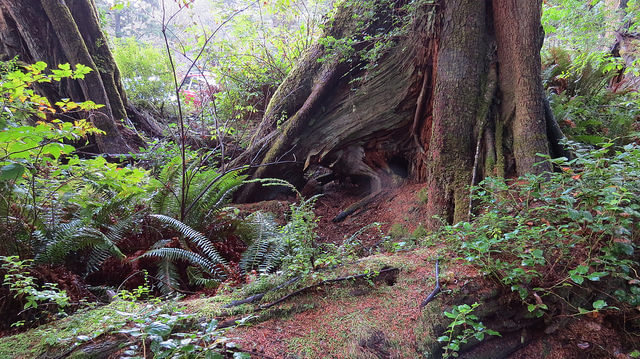
Forests have many layers, from tall trees to shrubs to ground covers. A landscape that resembles a forest will be more resilient in summer drought. Luke Jones photo.
Autumn is a great time to evaluate your landscape. How did it react to the lengthy, dry weather we had this past summer? Autumn is also a great time to get your garden ready for the winter rains. The steps you take now can also help to make your landscape more resilient next summer.
We set heat and dryness records this past summer. By August 8 we had set a record with no rain for 51 days. (The previous record was set back in 1951.) We broke heat records several times over the season.
Improving clay soils with organic matter
Now that the rains have come back, it may be hard to remember how hot and dry it was last summer. It seems like every year in the Pacific Northwest, rain saturates the landscape for months on end. The soils are sloppy and cold, and it seems they will always be that way. But once the rains disappear, it feels like it only takes a few weeks for the soils to become bone dry and dusty.
Most of this has to do with the heavy clay soils that are common here. Clay has microscopic pores. These small pores hold on to water a very long time, and then release the water slowly. When clay soil gets dry, it becomes almost hydrophobic, meaning that it will almost repel water.
The best way to break up clay soils and make them better at holding water during the dry summer months is to replenish the organic matter. You can easily do this by putting down a layer of mulch this fall.
Want to make it really easy? Let the leaves from trees and shrubs remain in your garden beds. They are Mother Nature’s way to replenish organic matter on the soil surface.
Left in place, leaves will help protect the soil surface from winter’s harsh rains. As they break down over time, they help build your soil’s organic matter. Leaves will also help regulate soil temperatures over the winter months. Soil stays warmer under an insulating blanket of leaves.
Plantings that work like a forest
Plants do much better when they are grown together in layers. For most landscapes, we suggest planting larger plants (usually trees) with enough space between them to grow evergreen and deciduous shrubs. The leaf canopies of the trees and shrubs will shade the soil and reduce the amount of evaporation that pulls water from the soil.
Underneath the shrubs, add groundcovers to carpet the rest of the bed. This also shades the soil surface. Surrounding all the plant material, the landscape will build up a thick layer of organic material as leaves, branches, flower petals and more fall to the ground.
If you go for a walk in the forest, you will find that the forest floor is completely covered in plant material. There is a wide variety of live plants along with decaying plant debris. As the debris breaks down, it replenishes organic matter to build healthy soils.
Our Pacific Northwest forests have tall majestic trees, like hemlocks, cedars and firs. Other canopies under the large trees may include plants such as vine maples and dogwoods, rhododendrons and berry bushes. On the forest floor are groundcovers such as salal, ferns and mosses.
You won’t find bare soil unless there is a disturbance to the forest, such as a flood or wildfire. All of these plants growing together and collectively shading the forest floor allows for any water (such as rain or melting snow) to stay in the soil for long periods of time.
Evaluate your landscape
So, look over your landscape now. What shape are your plants in after the harsh, dry summer months? Which ones still look good, and which ones suffered or even died? How can you improve the landscape and make it more resilient?
Fall is a great time to shop for new plants and get them in the ground. The cool fall and winter weather allows time for plant roots to establish before next year’s growing season.
Remember to plant in abundance to shade the ground. And plant for layering: taller plants with shorter plants under them and groundcovers as a base layer.
Then mulch any bare soil with leaves, compost, composted bark or arborist chips. Next year you will be amazed at how much better your garden will do when the summer drought shows up.
Taking time now to evaluate your landscape, then taking action to make it more resilient, will result in a big payoff next year.
More reading
Grow a 100-year old forest in your backyard – in just 10 years, treehugger.com.
Improving clay soils, Fine Gardening
